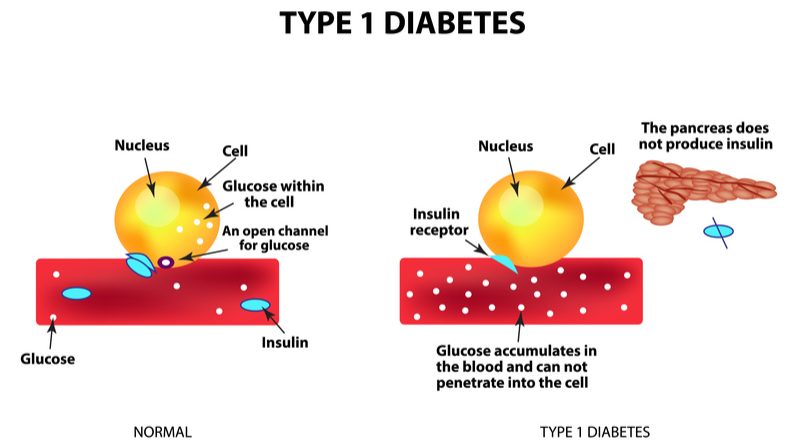Type 1 diabetes occurs when your immune system the bodys system for fighting infection attacks and destroys the insulin -producing beta cells of the pancreas. The destruction of beta cells in Type 1A.

Type 1 Diabetes Mellitus Nursing Care Management And Study Guide Nurseslabs
Explain why urinary tract infections are common in people with diabetes.

. Importantly insulin allows glucose to enter muscle and adipose cells stimulates the. Type 1 diabetes is an autoimmune condition that activates the immune system to destroy the insulin- producing cells in the pancreasThe pancreas a big gland behind the stomach stops producing insulin in type 1 diabetes because the immune system of the body has demolished the cells that create. Part B - Questions 1 Describe the pathophysiology of Type 1 Diabetes Mellitus.
This happens because your body attacks the cells in your pancreas that make the insulin meaning you. Type 1 diabetes is the result of lymphocytic infiltration and destruction of insulin-secreting beta cells in the pancreas islets of Langerhans. Insulin production diminishes when beta-cell mass falls until the available insulin is no longer sufficient to maintain normal blood glucose levels.
You need daily injections of insulin to keep your blood glucose levels under control. Defective insulin secretion by pancreatic β-cells and the inability of insulin-sensitive tissues to respond to insulin Insulin release and action have to precisely meet the metabolic. Nonimmune type 1B diabetes occurs secondary to other diseases and is much less common than autoimmune type 1A.
Type 1 diabetes is an autoimmune condition in which the immune system is activated to destroy the cells in the pancreas which produce insulin. If you have high blood glucose you may experience the following symptoms of type 1 diabetes which you can remember with the four Ts. Type 1 diabetes causes the level of glucose sugar in your blood to become too high.
This article will focus on the cause clinical features and implications of type 1 diabetes. There is no cure and it cannot be prevented. Type 1 diabetes is not linked to modifiable lifestyle factors.
Type 2 Diabetes Mellitus T2DM is one of the most common metabolic disorders worldwide and its development is primarily caused by a combination of two main factors. DIABETES ENDOCRINE Type 1 Diabetes immune-mediated β-cell destruction leading to insulin deficiency and lifelong insulin requirement. What causes type 1 diabetes.
When your immune system is functioning normally it attacks viruses and bacteria to fight off illness and infection. Insulin is an essential anabolic hormone that exerts multiple effects on glucose lipid protein and mineral metabolism as well as growth. About type 1 diabetes.
Occurs when the pancreas does not produce insulin. Its main clinical characteristic is hyperglycaemia. Ad With The Right Tools You Can Do Anything.
In this condition the immune system attacks and destroys the insulin producing beta cells of the pancreas. Pathophysiology of type 1 diabetes. Managing type 1 diabetes can take time to get used to but you can still.
We do not know what causes this autoimmune reaction. Explain how acute renal failure could. Type 1 diabetes is an autoimmune disorder.
Type 1 diabetes mellitus. It is now well-recognised that T1DM is an autoimmune disorder characterised by the destruction of insulin-producing pancreatic β-cells17 Like many other immune-mediated diseases T1DM shows heterogeneity in terms of age of onset severity of autoimmune response and efficacy of therapy. Type 1 Diabetes Mellitus is a syndrome characterized by hyperglycemia and insulin deficiency resulting from the loss of beta cells in pancreatic islets Mapes Faulds 2014.
Part B - Questions 1 Describe the pathophysiology of Type 1 Diabetes Mellitus. Describe the characteristics. Type 1 diabetes is a serious condition where your blood glucose sugar level is too high because your body cant make a hormone called insulin.
Diabetes mellitus is a complex metabolic disorder associated with an increased risk of microvascular and macrovascular disease. Explain why infection may lead to ketoacidosis. Insulin is normally synthesised in the pancreas by the b-cells of the islets of Langerhans in response to a glucose stimulus.
Describe the pathophysiology of type 1 diabetes. Type 1 diabetes mellitus. It happens when your body cannot produce enough of a hormone called insulin which controls blood glucose.
Scientists think type 1 diabetes is caused by genes and environmental factors such as viruses that might trigger the disease. Describe the pathophysiology of type 1 diabetes. Type 1 diabetes is fundamentally caused by the autoimmune destruction of these insulin-producing cells.
Explain why urinary tract infections are common in people with diabetes. A common distinction is made between type A. Let Us Help Manage Living With Diabates.
With type 1 diabetes it malfunctions and destroys healthy cells in the pancreas called B-cells that produce insulin. The last century has been characterised by remarkable advances in our understanding of the mechanisms leading to hyperglycaemia. The Path To Understanding Diabetes Starts Here.
Has had the infection for a week and has developed mild ketoacidosis because of the infection. Type 1 diabetes mellitus T1DM is an autoimmune disease that leads to the destruction of insulin-producing pancreatic beta cells. This is the result leads to total absence of insulin production.
In type 1 diabetes the pancreas is unable to produce insulin. Thirst being very thirsty and possibly hungry toilet urinating more often thinner experiencing unexplained weight. Type 1 diabetes mellitus T1DM is an autoimmune disease that leads to the destruction of insulin-producing pancreatic beta cells.
Explain how acute renal failure could develop. Describe the pathophysiology of type 1 diabetes.

Pathogenesis Of Type 1 Dm Type 1 Diabetes Glucose Intolerance Endocrine

Understanding Type 1 Diabetes 3e Chart 20x26 Type 1 Diabetes Diabetes Education Diabetes Information

0 Comments